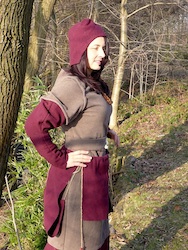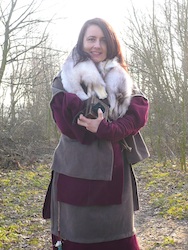|
In this period of time (900-1000 AD), Baltic region (north-eastern Europe plus north-western Russia) was inhabited by several different ethnic groups: Finno-Ugric peoples (Merya, Ves, Karelians, Laplanders, and others - not Finns themselves), northern Slavs (pre-Russians), and Balts (pre-Lithuanians). Lifestyle of all these peoples was similar, because it was determined by climate conditions and natural resources available.
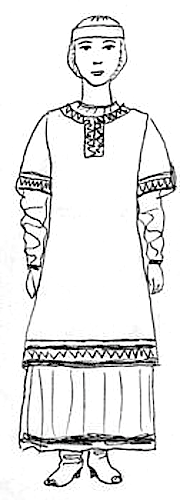
|
|
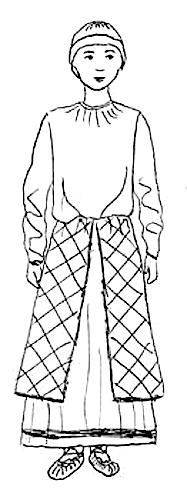
|
|
Clothing style of all mentioned peoples was similar also. A wardrobe consisted of same articles, similar in cut, but highly diverse in decoration: jewelry, accessories, arrangement of color details. To be historically accurate, all these were not a decoration in a contemporary meaning of the word. Embroidery patterns, necklaces, belts were, in fact, magic protective symbols, talismans, and signs of a tribe.
The outfit of a young Karelian woman displayed here includes the same items as the most ancient and archaic Slavic costume (a poneva-style one) does. They are:
- long-sleeved dress (similar to Russian "shirt")
- an archaic-style skirt, the same with Slavic "poneva raspashnaya" ("non-sewn skirt")
- an apron
- a woolen jerkin, similar to Russian "navershnik"
- a waistband
- boots
- jewelry
|
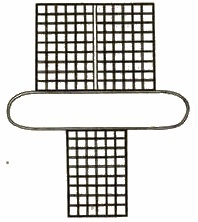 The "non-sewn skirt" is, actually, three separate pieces of cloth, which are hung on a thin rope. A rope is tied around a woman's waist, so pieces of cloth hang loosely; two of them cover a back side of hips, the front one should be positioned in accordance with local tradition: right in front, or on the side, or somewhere between front and side.
The "non-sewn skirt" is, actually, three separate pieces of cloth, which are hung on a thin rope. A rope is tied around a woman's waist, so pieces of cloth hang loosely; two of them cover a back side of hips, the front one should be positioned in accordance with local tradition: right in front, or on the side, or somewhere between front and side.
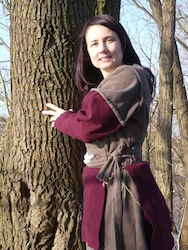 A waistband was thought as a powerful protection from any supernatural harm. Therefore, it should be made by the owner her/himself (or, at least, by a trustworthy person). Materials used for a waistband should have their own inherent magic powers. For this costume, a waistband is made of a piece of fabrics with turquoise and shells. In accordance with Northern beliefs, turquoise possessed divine powers because of its color – it was «pieces of sky and heaven, obtained far away, near the border between earth and sky». Shells, as a product of the sea, were connected with powers of The Ocean Lord.
A waistband was thought as a powerful protection from any supernatural harm. Therefore, it should be made by the owner her/himself (or, at least, by a trustworthy person). Materials used for a waistband should have their own inherent magic powers. For this costume, a waistband is made of a piece of fabrics with turquoise and shells. In accordance with Northern beliefs, turquoise possessed divine powers because of its color – it was «pieces of sky and heaven, obtained far away, near the border between earth and sky». Shells, as a product of the sea, were connected with powers of The Ocean Lord.
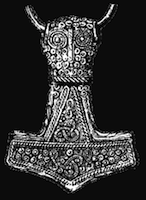 Other talismans used for this costume are: amber necklaces, and bronze Thorshammer – a sign of a Thunderstorm god named Thor (a «brother»-deity to Russian Perun and Lithuanian Perkunas).
Other talismans used for this costume are: amber necklaces, and bronze Thorshammer – a sign of a Thunderstorm god named Thor (a «brother»-deity to Russian Perun and Lithuanian Perkunas).
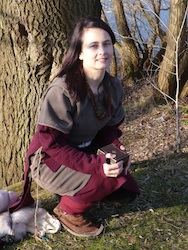 Leather boots for this costume were bought from a Finnish shoe maker who makes traditional Scandinavian footwear.
Leather boots for this costume were bought from a Finnish shoe maker who makes traditional Scandinavian footwear.
Being a Northern clothes, a costume includes such details as a hood, and, of course, a gorgeous scarf-like piece of a polar fox fur.
|

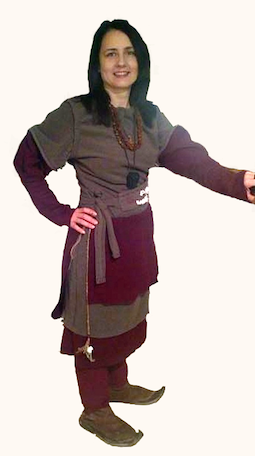


 The "non-sewn skirt" is, actually, three separate pieces of cloth, which are hung on a thin rope. A rope is tied around a woman's waist, so pieces of cloth hang loosely; two of them cover a back side of hips, the front one should be positioned in accordance with local tradition: right in front, or on the side, or somewhere between front and side.
The "non-sewn skirt" is, actually, three separate pieces of cloth, which are hung on a thin rope. A rope is tied around a woman's waist, so pieces of cloth hang loosely; two of them cover a back side of hips, the front one should be positioned in accordance with local tradition: right in front, or on the side, or somewhere between front and side.



